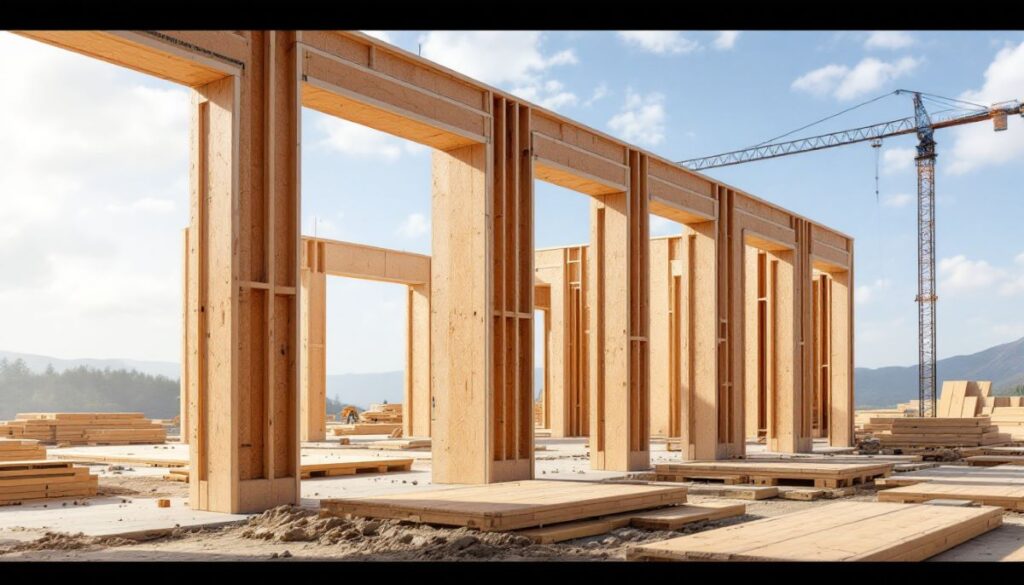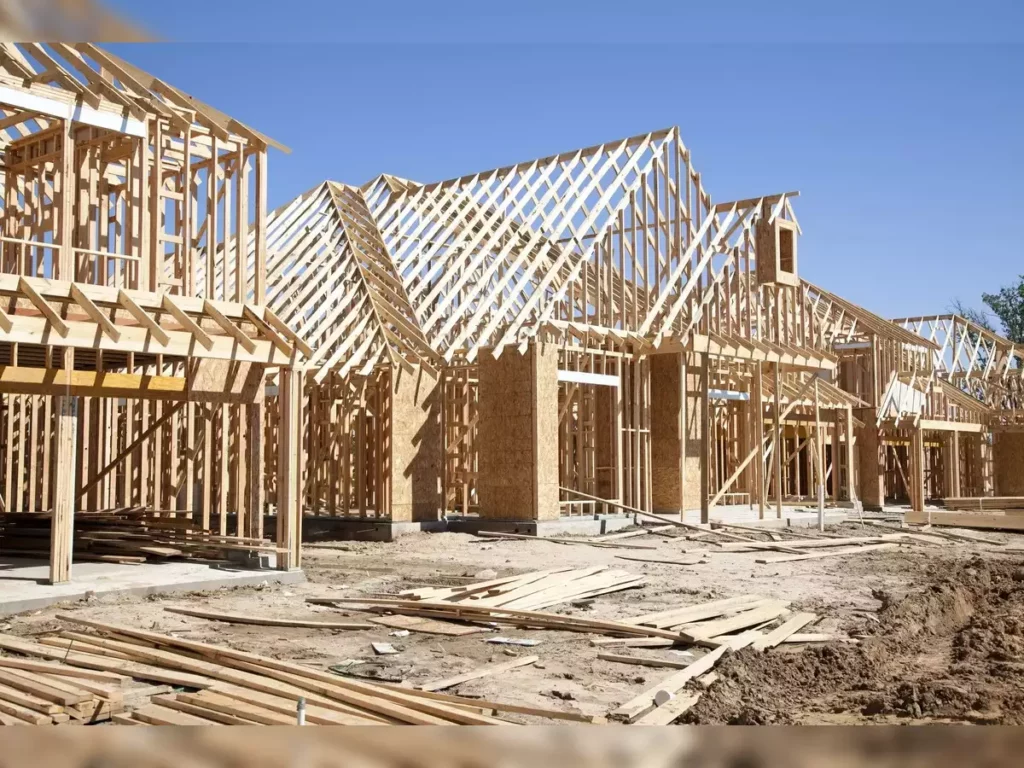LVL Formwork Timber: Benefits and Common Applications

What Is LVL Formwork Timber and How Is It Made?
Laminated Veneer Lumber (LVL) formwork timber is an innovative type of engineered wood specifically created for the demanding needs of concrete construction projects. Unlike traditional timber, which can have natural defects and inconsistencies, LVL is made by bonding multiple thin layers of wood together using waterproof adhesives. This process results in a strong and dependable material that outperforms regular timber in both durability and performance.
How Is LVL Formwork Timber Made?
The production of LVL involves a carefully controlled process to ensure the highest quality and strength. Here’s a breakdown of how it’s made:
- Selection of Wood Veneers: High-quality wood veneers, typically 3-4mm thick, are chosen for the production. These veneers are sourced from sustainably managed forests to minimise environmental impact.
- Grain Orientation: The veneers are arranged with their grain running parallel to the length of the final product. This alignment enhances the structural integrity of the LVL.
- Adhesive Application: Waterproof phenolic or melamine-based adhesives are applied to the veneers to create strong bonds between them.
- Pressing: The assembled layers are placed in specialised presses where they undergo intense heat and pressure. Temperatures reach 140-160°C, and pressures exceed 1.4 MPa during this process.
- Curing: The heat and pressure activate the adhesives, curing them and forming permanent bonds between the veneers.
Why Choose LVL Formwork Timber?
The unique manufacturing process of LVL offers several advantages over traditional timber, making it a smart choice for anyone searching for LVL timber buy options:
- Elimination of Defects: Natural wood defects such as knots, splits, and grain irregularities are eliminated through careful selection and processing.
- Consistent Density: The controlled manufacturing environment ensures uniform density throughout the material, resulting in predictable performance characteristics.
- Moisture Resistance: The use of waterproof adhesives creates bonds that resist moisture penetration, preventing delamination even in wet conditions.
Benefits of Using LVL Formwork Timber
LVL formwork timber provides numerous benefits for concrete construction projects:
- Strength and Reliability: With its superior load-bearing capacity compared to conventional timber, LVL can support heavier forms and structures.
- Dimensional Stability: The enhanced dimensional stability under varying moisture conditions minimises the risk of warping or twisting during use.
- Consistency in Performance: Batch after batch, LVL delivers consistent strength and durability, ensuring reliable results in every application.
This level of precision in manufacturing makes LVL formwork timber an ideal choice for critical concrete forming applications where reliability is paramount.
What Are the Key Benefits of Using LVL Formwork Timber?
The benefits of LVL formwork extend far beyond traditional timber solutions, making it a preferred choice for modern construction projects. Understanding these advantages helps you make informed decisions for your formwork requirements.
1. Superior Strength-to-Weight Performance
LVL formwork delivers exceptional strength-to-weight ratio characteristics that rival steel whilst maintaining significantly lighter handling properties. You can achieve load-bearing capacities comparable to steel beams at approximately 40% of the weight, reducing manual handling risks and installation time on site. This strength advantage stems from the engineered lamination process that eliminates natural wood defects.
2. Dimensional Stability and Durability
The engineered structure provides remarkable dimensional stability with minimal warping or twisting during concrete pours. You benefit from consistent form dimensions that produce superior concrete finishes without the unpredictable movement associated with traditional timber. The moisture resistance properties prevent swelling and shrinkage cycles that compromise formwork integrity.
LVL formwork demonstrates excellent resistance to rot, insects, and moisture penetration through its waterproof adhesive system. This durability extends service life significantly compared to conventional timber alternatives.
3. Economic and Environmental Advantages
Sustainability credentials include sourcing from responsibly managed forests and reduced material waste through precise manufacturing. You achieve cost-effectiveness through multiple reuse cycles and lower maintenance requirements. The energy-efficient manufacturing process utilises low VOC adhesives, supporting environmental compliance standards.
Enhanced site safety results from stable dimensions during concrete pouring, reducing formwork failure risks and improving worker confidence in structural integrity.
How Does LVL Formwork Compare to Traditional Timber and Steel?
1. LVL vs Traditional Timber: Strength Consistency
LVL vs traditional timber reveals significant performance differences that impact construction outcomes. LVL formwork timber delivers consistent strength properties across its entire length, whilst traditional timber varies considerably due to natural defects like knots and grain irregularities. You’ll find LVL maintains uniform load-bearing capacity, eliminating weak points that compromise structural integrity.

2. Weight Characteristics: Finding the Right Balance
Weight characteristics position LVL as the optimal middle ground. Steel formwork offers maximum strength but requires heavy machinery for installation and handling. Traditional timber provides lightweight handling but lacks the strength consistency you need for demanding applications. LVL formwork combines manageable weight with reliable strength, allowing your crew to handle materials efficiently without sacrificing performance.
3. Durability Advantages: Withstanding Site Conditions
Durability advantages become apparent during extended use cycles. Traditional timber warps, twists, and degrades when exposed to moisture and temperature fluctuations on construction sites. You’ll experience dimensional changes that affect concrete finish quality and require constant adjustments. LVL formwork maintains stable dimensions throughout multiple pours, ensuring consistent results.
4. Steel Formwork Comparison: Cost-Effectiveness Considerations
Steel formwork comparison highlights cost-effectiveness considerations. Steel requires significant initial investment and specialised handling equipment. LVL formwork offers comparable strength at reduced material costs whilst eliminating the need for heavy lifting equipment.
5. Construction Cost Savings: Efficiency Gains
Construction cost savings accumulate through reduced material waste and labour efficiency. You’ll achieve faster installation times with LVL formwork compared to steel systems, whilst enjoying superior reusability compared to traditional timber that deteriorates rapidly under site conditions. Click here to get more about Scaffold Mesh.
What Are the Common Applications of LVL Formwork Timber in Construction?
LVL applications are used in many different construction situations, making this engineered timber solution essential for modern building projects. The flexibility of LVL formwork timber allows contractors to use the same material for various structural needs while ensuring consistent performance standards.
Vertical Formwork Applications
Vertical formwork systems benefit significantly from LVL timber’s dimensional stability. You’ll find LVL formwork excelling in:
- Wall construction – providing smooth concrete finishes for both residential and commercial structures
- Column formwork – maintaining precise dimensions during concrete pouring
- Retaining walls – offering reliable support for heavy concrete loads
Horizontal Formwork Systems
Horizontal formwork applications showcase LVL’s load-bearing capabilities. Common uses include:
- Slab construction – supporting concrete during curing phases
- Beam formwork – creating precise structural elements
- Deck systems – providing stable platforms for concrete placement
Structural Framework Components
LVL formwork timber serves multiple roles within concrete construction frameworks:
- Edge boards – defining concrete boundaries with precision
- Joists and beams – distributing loads evenly across formwork systems
- Support structures – maintaining formwork stability during concrete placement
Load-Bearing Structures
Load-bearing structures utilise LVL’s engineered strength characteristics. You’ll encounter LVL formwork in:
- Floor support systems requiring high load capacity
- Roof trusses demanding consistent performance
- Structural framing for both residential developments and commercial buildings
The consistent grain structure of LVL formwork timber ensures predictable performance across these diverse applications, making it a reliable choice for Australian construction projects.
How Does Proper Installation Impact the Performance of LVL Formwork?
LVL installation guidelines are essential for ensuring optimal structural performance and safety on construction sites. By following established engineering standards, you can maximise the load-bearing capacity of your LVL formwork while keeping its dimensions accurate throughout the concrete pouring process.
Vertical Installation Techniques
When using vertical formwork, it’s crucial to pay close attention to alignment and bracing systems. Here are some key factors to consider:
- Ensure proper spacing between supports, which usually ranges from 600mm to 900mm centres depending on the concrete pressure and LVL thickness.
- Use laser levels or traditional spirit levels to achieve accurate plumb alignment.
- Implement adequate tie systems to resist lateral concrete pressure.
- Make proper corner connections using appropriate brackets and fasteners.
- Place walers strategically to distribute loads evenly.
Horizontal Installation Considerations
Horizontal LVL formwork requires different installation methods to prevent deflection during concrete placement. Here are some important aspects to keep in mind:
- Calculate deflection limits based on span lengths and expected loads.
- Determine critical propping intervals, which are typically every 1.2 to 1.5 metres for standard residential applications.
The order in which you install the formwork can directly impact the quality of the concrete finish. By maintaining consistent joint gaps and surface alignment, you can achieve smoother concrete surfaces that require minimal finishing work. Additionally, it’s important to consider temperature during installation as fluctuations can lead to expansion-related issues that compromise dimensional stability during the curing period.

What Maintenance Practices Ensure Longevity of LVL Formwork Timber on Site?
Effective formwork plywood maintenance directly impacts your project’s bottom line and construction timeline. You can maximise the lifespan of your LVL formwork timber through systematic care and proper handling procedures.
Routine Inspection and Cleaning Protocols
Daily visual inspections help you identify potential issues before they compromise structural integrity. Check for:
- Surface damage from concrete spillage or impact
- Edge deterioration that could affect dimensional stability
- Moisture penetration at joints or connection points
- Warping or deformation from improper handling
Clean your LVL formwork immediately after each use with appropriate cleaning agents. Remove concrete residue whilst it’s still workable – hardened concrete creates stress points that reduce panel lifespan. Use plastic scrapers rather than metal tools to prevent surface damage.
Strategic Storage Solutions
Proper storage conditions preserve your investment between uses. Store panels flat on level bearers with adequate support every 600mm to prevent sagging. Maintain consistent spacing between stacked panels using dry timber battens.
Protect stored formwork from direct weather exposure using waterproof covers whilst ensuring adequate ventilation. Moisture trapped against panel surfaces accelerates deterioration and reduces the adhesive bond strength that gives LVL its superior performance characteristics.
These durability tips help you achieve 20-30 reuses from quality LVL formwork, significantly reducing your material costs per pour compared to traditional alternatives.

Leave a Reply